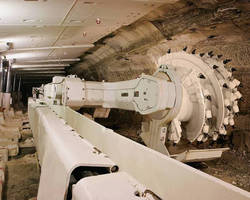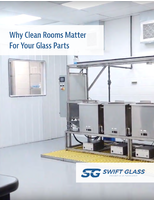New Technology Mines One of World's Oldest Chemicals
Share:

If you grow it, process it, eat it, wear it, clean it or cleanse with it, watch it, listen to it, ride in it or ride on it, somewhere along the line soda ash derived from trona is involved. While the use of soda ash dates back more than five centuries, its modern source-from mined trona-is measured in mere decades.
After salt and lime, soda ash is the third chemical known to have been used by man, dating back at least 3,500 years to the Egyptians who extracted it from wood ashes--hence the name. Today, soda ash from trona is involved in virtually every aspect of life, through the manufacturing of glass, in chemical manufacturing, fertilizers, soaps and detergents, pulp and paper, flue gas desulferization, and water treatment.
It wasn't until the 18th Century (1791) that LeBlanc discovered the process for extracting soda ash using sulfur, salt, and coal gas, and the 19th Century (1860) that Ernest Solvay modified the process to achieve a better soda ash using brine, ammonia, salt, coal gas, and carbon dioxide. Finally, in the 20th Century (1938) the presence of trona was found in a core sample while drilling for oil at the John Hay No. 1 Well south of Westvaco, Wyoming.
Trona was first deep-mined in 1947 by Westvaco Chlorine. Shortly after that, FMC Corporation acquired Westvaco's chemical business, including the mine, and then added the Granger Mines. Today, Philadelphia-based FMC-a $3.5 billion international corporation with more than 5,000 employees-is the world's largest natural soda ash producer. The company, begun in 1883, maintains a leading position in three chemical markets: agriculture, specialty, and industrial.
In addition to FMC, Wyoming trona is mined by General Chemical Industrial Products, Solvay Minerals, and OCI Chemical. The beds in which they all operate began forming 50 million years ago when deposited volcanic ash later was covered by Lake Gosiute, which reportedly once spread over a 15,000 square-mile area. The deposits resulted in more than 42 beds of trona in the Green River Basin of southwest Wyoming, stretching from the Unitah Mountains of Utah in the south, along the Wyoming Range to the west, the Rock Springs uplift to the east to the Wind River and Gros Ventre Mountains in the north.
Beginning in the 1950s, soda ash from trona steadily replaced Solvay "synthetic" soda ash in the U.S., with the last Solvay plant closing in the 1970s. Today, more than 90% of the soda ash used in America comes from Wyoming trona mines, along with more than 30% of the world's supply.
In the Green River Basin, 25 of the thickest beds contain 127 billion tons (115 billion tonnes) of trona with 40 billion tons considered recoverable. This is enough for 2,350 years of extraction at today's rate of mining. Bed 1 is 3,500 feet (1070 metres) beneath the surface and Bed 25 is 800 feet (245 metres) down.
Typically, trona is processed into soda ash (sodium carbonate, Na2CO3) at a recovery rate of 1 ton (.90 tonnes) of soda ash for every 1.7 tons (1.5 tonnes) of trona. Industry-wide, Wyoming trona mines employ more than 2,225 people, annually mining more than 17 million tons (15 million tonnes) of trona to produce more than 10 million tons (9 million tonnes) of soda ash, shipped from the mine by rail bagged or in bulk.
About 44% of the trona in Wyoming is produced from Federal government lands and some 56% from State government and private lands, all of it deep-mined using boring machines with continuous haulage, continuous miners with continuous haulage and shuttle cars, and, at the Solvay and FMC mines, longwalls.
The most successful application of longwall mining has been at the FMC Westvaco Mine. "Here, we have 225 people involved in the mining some 4.6 million tons of clean soda ash," said Tim Davis, senior mine engineer and longwall project manager. "We run 10 hour shifts, 24 hours a day, 7 days a week, usually 11 production shifts a week, and six or seven maintenance shifts.
"Presently," Davis said, "we have two borer miners on longwall development work and a third machine working on our bleeders, all working in tandem with JOY 10SC-32 shuttle cars. The shuttle cars dump onto conveyor belts that transport the trona to skip hoists for transfer to the surface and the processing plant.
"Unlike in coal mining," Davis explained, "in addition to the headgate and tailgate, we drive a third entry up the center of the longwall panel, about 125 feet from the headgate, then mine through those pillars as we advance the longwall."
Westvaco's longwalls typically measure 750 feet (230 metres) across the face by 9,400 feet (2865 metres), with 1,600 feet (490 metres) of cover. According to Davis, two problems in mining trona can be excess water and the size of the material as it comes off the longwall face.
"For one thing, trona is water soluble. When we get it outside, the first thing we do is calcify it, drive off the water, so the less water the better. Also, when trona and water do mix, it runs into places you don't want it to run and then sets up like concrete," Davis added. "Fortunately, while extracting trona does generate dust, it is a nuisance dust, not a hazardous dust, so we don't have to use as much water for dust suppression, as they do in coal mining.
"The second problem we encounter is the size of the slabs of material that comes off the longwall face," Davis continued. "While we continue to work on that problem, making adjustments to the shearer, the shield operators still have to at times breakup the large slabs using jackhammers."
As explained by Davis, FMC's Westvaco mine is 1,550 feet (475 metres) below ground and has more than 2,500 miles (4000 kilometers) of tunnels stretched out over 36 square miles. Entries are 16 feet (5 metres) wide, 9 feet (3 metres) high and the mine operates at 1,000 tons (900 tonnes) per hour, with an additional 100 tons (90 tonnes) per hour coming from a unique solution mining process involving the injection of water in another area of the mine.
According to Scott Lewis, Joy sales engineer, "Allied Chemical (now General) pioneered longwall mining of trona in 1973. FMC began longwall mining in 1981. Longwall mining was halted briefly in 1987 for retooling. In 1993, the mine replaced the longwall system with a JOY longwall system, adding a JOY 6LS5 shearer in 1996. Now equipped with a JOY 7LS5 shearer, the current longwall is recovering 50% more of the in-seam trona than the mine had been realizing in borer mining."
Along with the JOY 7LS5 shearer, the FMC Westvaco longwall installed this past January consists of 131 JOY 2x870 ton shields, 2x1000 hp JOY armored face conveyor and 42x146 flat link chain, and a 450 hp stageloader with a 42mm JOY BROADBAND low-profile chain. The longwall system also features Joy's FACEBOSS control platform.
According to Lewis, "With a combination of assistance tools, Joy's FACEBOSS control platform provides the operator with automated cut sequence settings, advanced diagnostics with on-board graphic displays, and machine performance monitoring and analysis. Combined, this system ensures the operator can achieve the optimal balance of production rate and cost.
"Since its introduction in 2006," Lewis added, "the FACEBOSS control platform has proven so successful that today it is standard on all JOY 7LS shearers, as it is on all continuous miners, flexible conveyor trains, and armored face conveyors."




